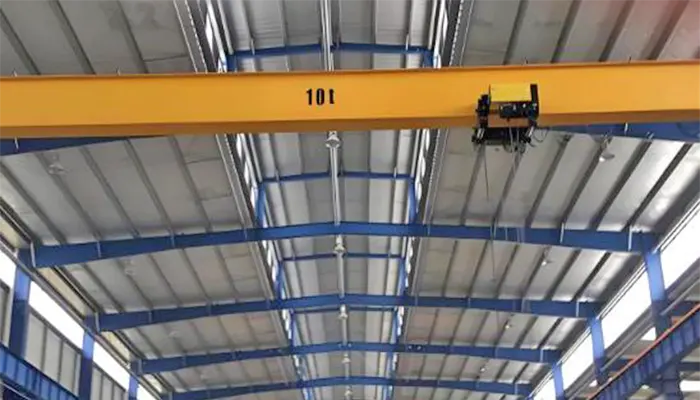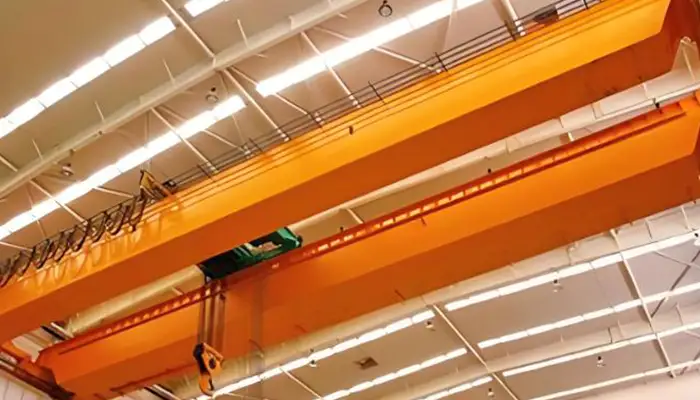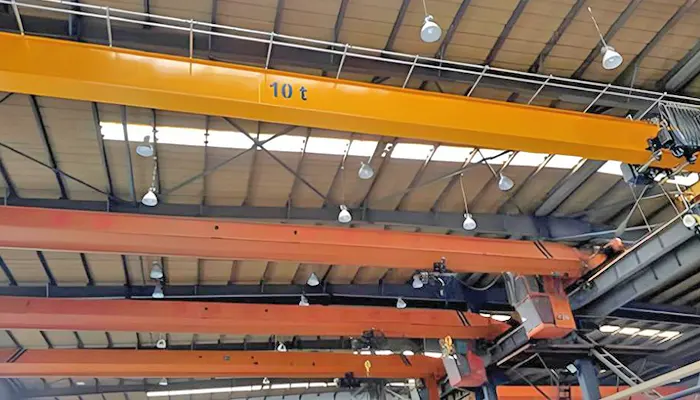How Custom Features Influence the Cost of a 10-Ton Overhead Crane
How Custom Features Influence the Cost of a 10-Ton Overhead Crane
Custom features increase the cost of a 10-ton overhead crane by adding specialized materials, advanced technologies, and tailored engineering solutions.In the industrial operations, where efficiency and safety reign supreme, the choice of overhead crane can make a significant difference. At the heart of this decision lie custom features – the tweaks and enhancements tailored to specific needs. But what exactly are custom features, and why do they hold such sway over the price of a 10 ton overhead crane? Join us on a journey to uncover the intricacies of customizations and their profound impact on pricing.
Custom features, in the realm of overhead cranes, refer to the tailored modifications and enhancements made to a standard crane design. These alterations cater to unique requirements, whether it be adjusting dimensions, incorporating advanced control systems, or adapting to challenging environmental conditions.
Why are custom features pivotal in the pricing puzzle of a 10 ton overhead crane? Simply put, they are the key drivers that transform a standard crane into a bespoke solution. Each customization directly influences the crane's performance, functionality, and suitability for specific tasks. Consequently, the inclusion or exclusion of these features significantly impacts the overall cost of the crane.
Single girder 10 ton overhead cranes
Basic Features of a 10 Ton Overhead Crane
Defining the Standard: At the core of every 10 ton overhead crane lies a set of fundamental components that form its backbone. These components work in harmony to facilitate the lifting, maneuvering, and positioning of heavy loads within industrial settings.
Components:
Bridge: The bridge, also known as the girder or runway beam, forms the horizontal framework upon which the crane moves. It spans the width of the working area and supports the hoist and trolley.
Hoist: The hoist is the lifting mechanism responsible for raising and lowering loads. It consists of a motorized drum or chain system, along with a hook or other attachment point for securing the load.
Trolley: The trolley traverses along the bridge, allowing the hoist to move horizontally across the workspace. It provides flexibility in positioning the load precisely.
End Trucks: End trucks are mounted on either side of the bridge and house the wheels or tracks on which the crane moves along the runway.
Controls: Control mechanisms, whether pendant or remote, enable operators to manipulate the crane's movements with precision and ease.
Specifications and Functionalities:
The typical specifications and functionalities of a 10 ton overhead crane provides insight into its capabilities and limitations.
Specifications: - Capacity: A 10 ton overhead crane is designed to lift and transport loads weighing up to 10 tons, providing substantial lifting power for medium to heavy-duty applications.
Span Length: The span length refers to the distance between the runway rails or supports. Standard configurations offer spans tailored to the dimensions of the workspace.
Height Clearance: The vertical distance between the crane's lowest point and the highest point of obstruction determines the height clearance, ensuring unhindered movement within the workspace.
Functionalities:
Lifting: The primary function of the crane is to lift and lower loads safely and efficiently, utilizing the hoist mechanism.
Traveling: The crane can traverse along the length of the bridge, covering the entire span of the workspace, thanks to the trolley mechanism.
Positioning: Precision positioning capabilities allow operators to place loads with accuracy, enhancing productivity and safety.
Safety Features: Standard safety features, such as overload protection, emergency stop buttons, and limit switches, safeguard both personnel and equipment during crane operations.
By understanding the foundational elements and operational capabilities of a standard 10 ton overhead crane, businesses can assess their basic requirements before delving into the realm of customizations. Stay tuned as we explore the transformative power of custom features in the subsequent sections!
Double girder 10 ton overhead crane for sale
Types of Custom Features
Structural Customizations
Customizing the structural aspects of a 10 ton overhead crane involves tailoring its dimensions and design to suit specific spatial constraints and operational requirements. Here are three key structural customizations that businesses may consider:
- Span Length Adjustments: Span length adjustments involve altering the distance between the runway rails or supports to accommodate varying workspace dimensions. Whether spanning a wide manufacturing floor or navigating through narrow aisles, customizing the span length ensures optimal utilization of space and enhances operational efficiency.
- Height Modifications: Height modifications entail adjusting the vertical clearance of the crane to accommodate overhead obstacles or maximize lifting height. By customizing the crane's height, businesses can mitigate clearance constraints and optimize vertical space utilization within the workspace, thereby expanding the range of lifting applications.
- Girder Design Variations: Girder design variations offer flexibility in selecting the appropriate girder type and configuration based on specific load requirements and structural considerations. Whether opting for a single girder or double girder design, customizing the girder ensures optimal load-bearing capacity, durability, and structural integrity tailored to the application's demands.
These structural customizations empower businesses to tailor the 10 ton overhead crane to their unique operational needs, optimizing space utilization, enhancing safety, and maximizing productivity. As we delve deeper into the realm of custom features, we'll explore additional enhancements that further elevate the crane's performance and versatility. Stay tuned for insights into operational customizations and environmental adaptations in the upcoming sections!
Operational Customizations
Operational customizations are geared towards enhancing the functionality, efficiency, and safety of a 10 ton overhead crane. By incorporating advanced control systems, bolstering safety features, and integrating automation, businesses can optimize crane performance and streamline operations. Here are three key operational customizations:
- Control Systems Upgrades: Upgrading control systems involves implementing advanced technologies to enhance crane maneuverability, precision, and ease of operation. Features such as variable frequency drives (VFDs), joystick controls, and radio remote systems enable smoother acceleration, deceleration, and precise load positioning, thereby improving productivity and operator comfort.
- Safety Features Enhancements: Enhancing safety features is paramount to ensuring a secure working environment and mitigating risks associated with crane operations. Custom safety enhancements may include overload detection systems, collision avoidance sensors, anti-sway technology, and zone control mechanisms. By integrating these features, businesses can minimize the likelihood of accidents, protect personnel and assets, and adhere to stringent safety regulations.
- Automation Integration: Integration of automation technologies enables seamless coordination and optimization of crane operations, reducing manual intervention and enhancing efficiency. Automated features such as load monitoring, inventory tracking, and predictive maintenance facilitate proactive decision-making, minimize downtime, and optimize resource utilization. Additionally, automation integration enables interoperability with other machinery and systems, fostering a cohesive and interconnected industrial ecosystem.
By investing in operational customizations, businesses can elevate the performance, safety, and reliability of their 10 ton overhead crane, unlocking new levels of efficiency and productivity. As we continue our exploration, we'll delve into environmental adaptations that further enhance the crane's resilience and longevity. Stay tuned for insights into adapting to challenging environmental conditions and optimizing crane performance in diverse operating environments. 
10 ton overhead crane, customized for your workshop and warehouse
Environmental Adaptations
Environmental adaptations are essential for ensuring the durability, reliability, and safety of a 10 ton overhead crane in diverse operating conditions. By incorporating features such as corrosion-resistant coatings, temperature-resistant components, and adaptations for hazardous environments, businesses can prolong the crane's lifespan and maintain optimal performance. Here are three key environmental adaptations:
- Corrosion-Resistant Coatings: Corrosion-resistant coatings provide a protective barrier against rust, oxidation, and chemical damage, particularly in harsh industrial environments. By applying specialized coatings such as epoxy, zinc, or polyurethane, businesses can safeguard crane components exposed to moisture, corrosive substances, and atmospheric pollutants, thereby minimizing maintenance requirements and extending the crane's service life.
- Temperature-Resistant Components: Temperature-resistant components are essential for ensuring crane reliability and performance in extreme temperature environments. Heat-resistant materials, insulation, and cooling systems help mitigate the effects of high temperatures, preventing component degradation, mechanical failures, and operational disruptions. Similarly, cold-resistant materials and heating elements maintain crane functionality and prevent freezing-related issues in sub-zero conditions, ensuring uninterrupted operation.
- Hazardous Environment Adaptations: Adapting overhead cranes for hazardous environments requires specialized features to mitigate risks associated with flammable, explosive, or corrosive substances. Explosion-proof enclosures, spark-resistant materials, and sealed electrical components prevent ignition sources and safeguard against fire and explosion hazards. Additionally, incorporating intrinsically safe controls, ventilation systems, and leak detection mechanisms enhances worker safety and compliance with regulatory standards in hazardous environments.
By integrating environmental adaptations into the design and construction of a 10 ton overhead crane, businesses can enhance its resilience, reliability, and safety in challenging operating environments. These adaptations not only protect the crane from environmental hazards but also safeguard personnel, assets, and operations, ensuring uninterrupted productivity and operational efficiency. As we conclude our exploration of custom features and their impact on pricing, we'll reflect on the significance of these adaptations and their role in optimizing crane performance and longevity.
Factors Influencing Pricing
Understanding the various factors that influence the pricing of a 10 ton overhead crane is crucial for businesses seeking to make informed procurement decisions. From material costs to engineering complexity and installation requirements, several key factors contribute to the overall pricing of customized overhead cranes. Let's explore these factors in detail:
Material Costs
Cost Variation Based on Materials Used in Customizations: The choice of materials significantly impacts the overall cost of customizing an overhead crane. High-quality, durable materials such as stainless steel or alloy steel may incur higher upfront costs but offer superior longevity and performance, reducing long-term maintenance expenses. Conversely, opting for lower-grade materials may result in initial cost savings but could lead to increased maintenance and replacement costs over time.
Engineering Complexity
Impact of Design Intricacy on Overall Pricing: The complexity of engineering design directly influences the pricing of customized overhead cranes. Intricate designs requiring specialized engineering expertise, innovative solutions, and advanced modeling techniques may command higher prices due to the additional time, resources, and expertise involved in their development. Conversely, simpler designs with standardized components and fewer customization requirements may offer cost-effective solutions for businesses with budget constraints.
Manufacturing Processes
Influence of Specialized Manufacturing Techniques: The adoption of specialized manufacturing techniques, such as precision machining, laser cutting, and robotic welding, can significantly impact the pricing of customized overhead cranes. While these advanced manufacturing processes may increase production costs, they offer benefits such as improved accuracy, consistency, and product quality, ultimately enhancing the crane's performance and longevity.
Installation Requirements
Additional Labor Costs for Custom Installations: Customized overhead cranes often require tailored installation solutions to accommodate specific spatial constraints, operational requirements, and safety considerations. As a result, custom installations may incur additional labor costs associated with site preparation, assembly, integration of custom components, and testing. Factors such as site accessibility, complexity of installation, and regulatory compliance requirements can further influence installation costs, contributing to the overall pricing of the crane.
By considering these factors holistically, businesses can gain a comprehensive understanding of the pricing dynamics associated with customizing and procuring a 10 ton overhead crane. Balancing cost considerations with performance, reliability, and safety requirements is essential for making informed investment decisions that align with long-term business objectives. As we conclude our exploration, we'll reflect on the importance of conducting thorough cost-benefit analyses and leveraging expert guidance to optimize crane selection and customization processes.
Comparative Analysis
Comparison of Pricing between Standard and Customized 10-Ton Overhead Cranes
- Standard Crane Pricing: A standard 10 ton overhead crane typically comes with predefined specifications and features, making it a cost-effective option for businesses with basic requirements. The pricing of standard cranes is relatively lower compared to customized options due to mass production, standardized components, and simplified engineering and manufacturing processes.
- Customized Crane Pricing: Customized 10 ton overhead cranes offer tailored solutions to meet specific operational needs and challenges. While customization allows for flexibility and optimization, it also entails additional engineering, manufacturing, and installation costs. As a result, customized cranes are generally priced higher than standard configurations, reflecting the added value and benefits derived from tailored features and functionalities.
Evaluation of Cost-Benefit Analysis for Various Custom Features
- Structural Customizations: Structural customizations, such as span length adjustments and height modifications, optimize space utilization and enhance operational efficiency. While these customizations incur additional upfront costs, they can result in long-term savings by maximizing productivity and minimizing downtime.
- Operational Customizations: Operational customizations, including control systems upgrades and safety features enhancements, improve crane functionality, operator safety, and efficiency. Despite the higher initial investment required for advanced technologies and safety enhancements, the benefits of increased productivity, reduced accidents, and regulatory compliance outweigh the upfront costs.
- Environmental Adaptations: Environmental adaptations, such as corrosion-resistant coatings and temperature-resistant components, protect the crane from damage and degradation in challenging operating environments. While these adaptations involve additional expenses, they ensure crane longevity, reliability, and safety, resulting in reduced maintenance costs and operational disruptions over time.
Long-Term Savings versus Initial Investment
When considering the investment in a 10 ton overhead crane, businesses must weigh the upfront costs against the long-term savings and benefits derived from customization. While standard cranes offer lower initial investment, they may lack the tailored features and capabilities necessary to optimize operations and withstand challenging environments.
Customized cranes, on the other hand, require a higher upfront investment but offer greater flexibility, efficiency, and longevity. By investing in custom features that align with operational requirements and challenges, businesses can realize significant long-term savings through improved productivity, reduced maintenance costs, and enhanced safety and compliance.
Ultimately, the decision between standard and customized overhead cranes hinges on the specific needs, priorities, and budget constraints of the business. Conducting a thorough cost-benefit analysis and consulting with crane experts can help businesses make informed decisions that maximize ROI and long-term value. As we conclude our comparative analysis, let's reflect on the key considerations and takeaways for businesses navigating the procurement and customization process for 10 ton overhead cranes.
Conclusion
Custom features play a pivotal role in determining the pricing of a 10 ton overhead crane, reflecting the tailored solutions and added value they offer to businesses. Structural customizations optimize space utilization and operational efficiency, while operational enhancements improve functionality, safety, and productivity. Environmental adaptations safeguard the crane from damage and degradation in challenging operating environments, ensuring longevity and reliability. While custom features entail additional upfront costs, they deliver long-term benefits that justify the investment for businesses seeking to optimize crane performance and maximize ROI.
Summary of Key Findings
Impact of Custom Features on the Price of a 10-Ton Overhead Crane
Structural customizations, operational enhancements, and environmental adaptations contribute to the pricing of a 10 ton overhead crane by addressing specific operational needs and challenges.
Customized cranes are priced higher than standard configurations due to additional engineering, manufacturing, and installation costs associated with tailored features and functionalities.
Despite the higher upfront investment, customized cranes offer greater flexibility, efficiency, and longevity, resulting in significant long-term savings and benefits for businesses.
When selecting custom features for overhead cranes, businesses must carefully evaluate their operational requirements, challenges, and budget constraints. Conducting a thorough needs assessment and cost-benefit analysis is essential for identifying the most suitable customizations that align with organizational priorities and objectives. Consulting with crane experts and leveraging industry best practices can help businesses make informed decisions that optimize crane performance, safety, and reliability while maximizing ROI and long-term value.
In conclusion, the strategic selection and customization of overhead cranes are paramount for driving operational efficiency, productivity, and safety in industrial settings. By investing in custom features that address specific needs and challenges, businesses can unlock the full potential of their overhead crane systems and achieve sustainable growth and success.




